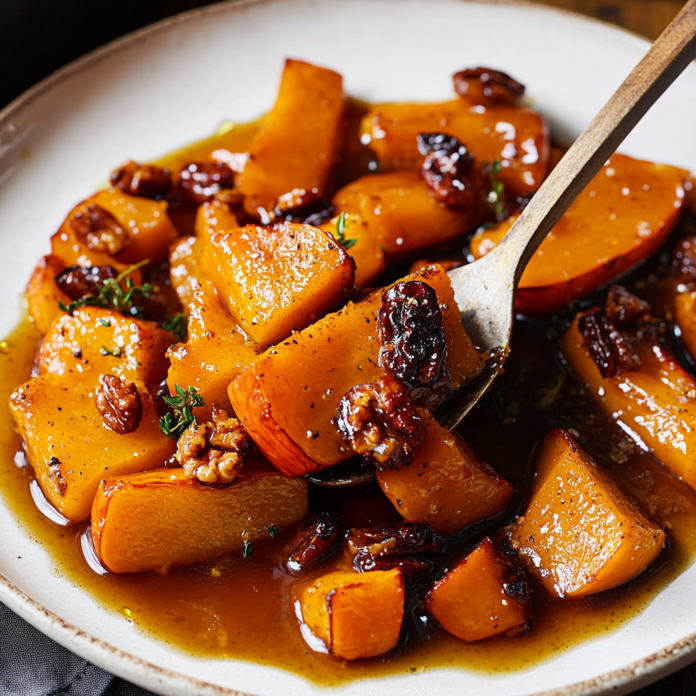Introduction and Quick Summary
Roasted Butternut Squash with Maple Glaze is a delectable dish that brings the warmth of autumn to your table. This recipe combines the natural sweetness of butternut squash with a rich maple glaze that enhances its flavor profile to perfection. Not only is this dish visually appealing with its vibrant orange hue, but it also offers a delightful balance of sweet and savory notes that make it an ideal side dish for any meal. Whether you’re preparing a family dinner or hosting friends for a festive gathering, this roasted butternut squash will surely impress.
The preparation is straightforward and requires minimal ingredients, making it accessible even for novice cooks. You can enjoy this dish alongside grilled meats or as part of a hearty vegetarian feast. The roasting process caramelizes the sugars in the squash, creating a tender texture that pairs beautifully with the sticky maple glaze. With each bite, you’ll experience the comforting flavors that define fall cooking. So roll up your sleeves and get ready to bring home the essence of autumn with this delightful recipe.
Main Ingredients
Butternut Squash
Butternut squash is the star ingredient in this recipe. You’ll need about 2 pounds of fresh butternut squash. Choose firm ones that feel heavy for their size and have smooth skin without blemishes. The flesh is sweet and nutty when cooked, making it perfect for roasting. To prepare the squash, peel it using a vegetable peeler and cut it into 1-inch cubes to ensure even cooking.
Maple Syrup
For the glaze, you will need 1/4 cup of pure maple syrup. This natural sweetener adds depth to the dish while providing that signature sweetness we all love in fall recipes. Opt for grade A or B maple syrup depending on your preference; darker syrups tend to have a more robust flavor and work wonderfully in glazes.
Olive Oil
You will require 2 tablespoons of extra virgin olive oil to enhance the flavor and help achieve that beautiful caramelization on the squash during roasting. Olive oil not only adds richness but also assists in achieving a crispy texture on the outside while keeping the inside tender.
Salt
A teaspoon of salt is essential for balancing flavors in any recipe. It helps bring out the natural sweetness of the squash while complementing the richness of the maple syrup. Use fine sea salt for even distribution over your veggies.
Ground Cinnamon
For an added touch of warmth, include 1/2 teaspoon of ground cinnamon in your glaze mix. This spice pairs excellently with both sweet and savory dishes, enhancing their overall taste profile while evoking cozy autumn vibes.
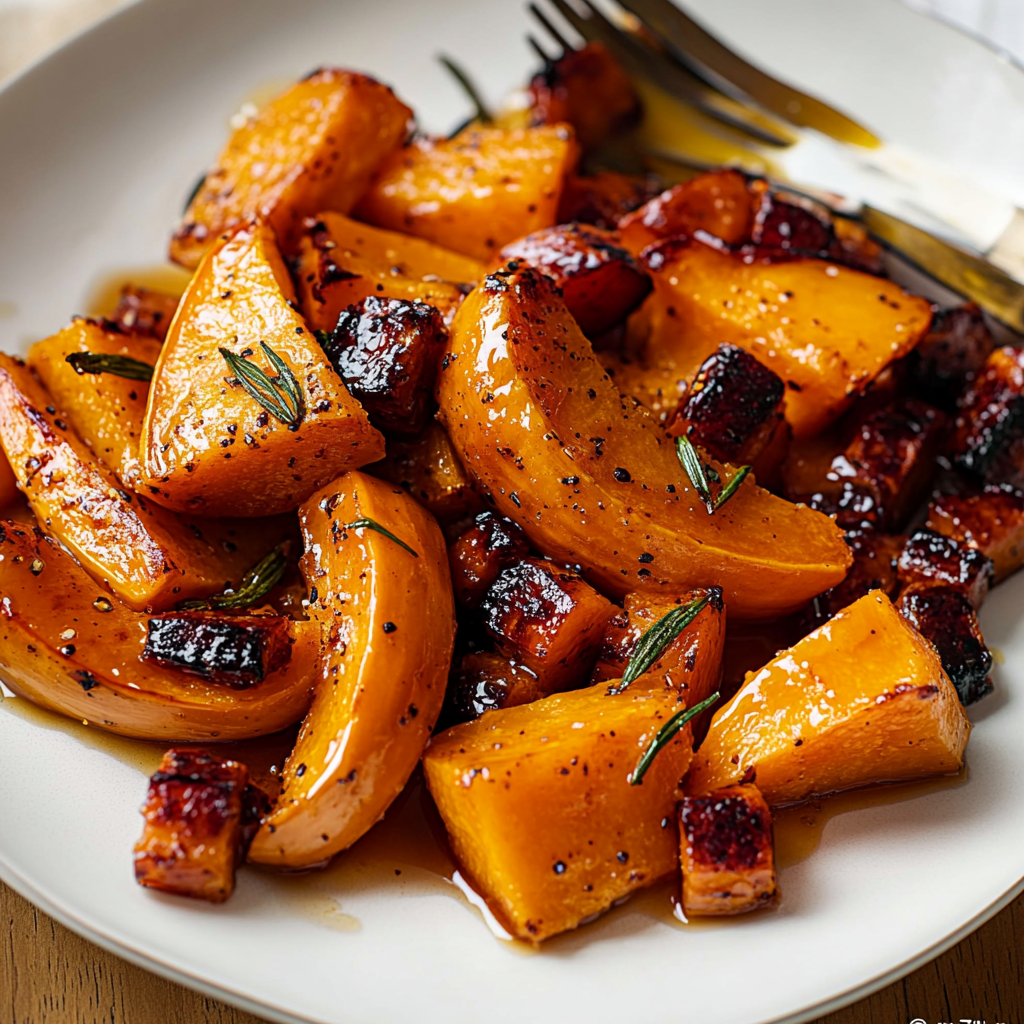
How to Prepare Roasted Butternut Squash with Maple Glaze
Step 1: Preheat Your Oven
Begin by preheating your oven to 400°F (200°C). Properly preheating ensures even cooking throughout your butternut squash pieces and helps achieve that desirable caramelized exterior. While waiting for your oven to heat up, line a large baking sheet with parchment paper or lightly grease it with olive oil to prevent sticking during roasting.
Step 2: Prepare Your Ingredients
While your oven heats up, wash and peel your butternut squash thoroughly before cutting it into cubes as specified earlier. Place those cubes in a large mixing bowl where you can easily coat them in other ingredients later on. In another small bowl, combine your maple syrup, olive oil, salt, and ground cinnamon until well-blended; this mixture will serve as your flavorful glaze.
Step 3: Coat the Squash
Pour the prepared maple glaze over the cubed butternut squash in your mixing bowl. Using clean hands or a spatula, gently toss everything together until every piece is evenly coated in that luscious mixture—this step is crucial as it ensures every bite carries those wonderful flavors when roasted! Transfer the glazed pieces onto your prepared baking sheet spread out evenly; avoid overcrowding them so they can roast properly without steaming each other.
Step 4: Roast Until Tender
Place your baking sheet into the preheated oven and roast for approximately 25-30 minutes or until fork-tender—make sure you stir them halfway through cooking time! This allows all sides to receive equal heat exposure resulting in golden-brown perfection across each cube! Once done roasting remove from oven letting cool slightly before serving.
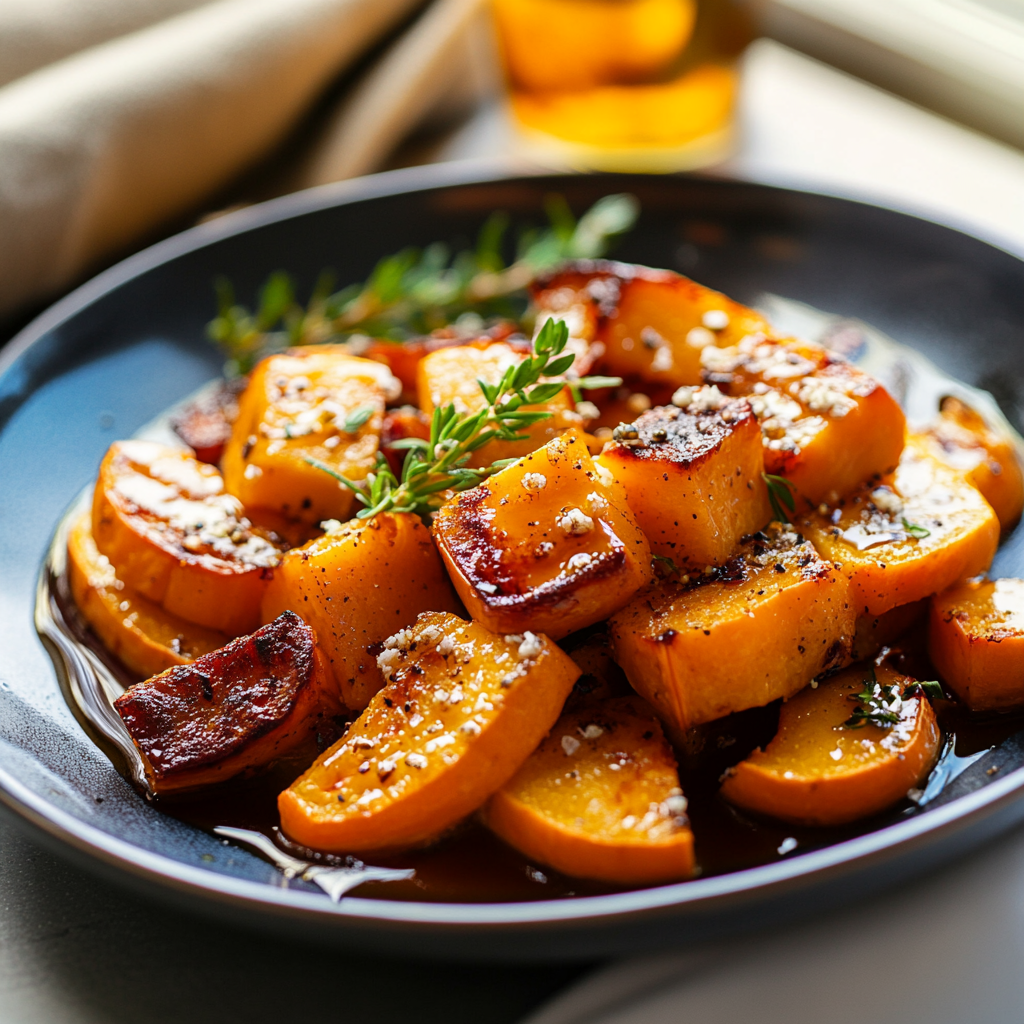
Serving and Storing Tips
Serving Suggestions
Roasted Butternut Squash with Maple Glaze makes an excellent side dish paired alongside roasted chicken or grilled pork chops—its sweet yet savory flavor balances nicely against heartier mains! For vegetarian options consider serving it over quinoa or mixed greens drizzled additionally with balsamic vinaigrette giving contrast both visually & taste-wise! Garnish finished servings lightly sprinkled toasted walnuts or pumpkin seeds offering crunch & nutrition!
Storage Guidelines
To store leftovers effectively after enjoying this delicious meal allow cooled roasted butternut squash pieces to be transferred into airtight containers; they can last up to five days refrigerated without losing quality! Reheat gently either by microwaving briefly or placing back into an oven set at low temperature until warmed through again—be cautious not overcook as they may dry out unnecessarily during reheating! For longer storage consider freezing portions wrapped tightly in freezer-safe bags where they may be kept frozen up till three months ahead!
By following these simple steps outlined above you’re sure not only to create an amazing dish full flavor & nutritional benefits—but also gain confidence preparing future meals centered around seasonal ingredients too! Enjoy every moment spent savoring Roasted Butternut Squash with Maple Glaze!
Mistakes to avoid
When preparing Roasted Butternut Squash with Maple Glaze, it’s essential to steer clear of common pitfalls that can affect the dish’s flavor and texture.
One major mistake is not properly peeling and cutting the squash. Many people underestimate the importance of uniform pieces. If you cut the squash into uneven sizes, some pieces may burn while others remain undercooked. Always use a sharp knife for peeling and cutting, and aim for cubes around one-inch thick to ensure even roasting.
Another frequent error is neglecting to season adequately. The glaze enhances the natural sweetness of butternut squash, but without proper seasoning, it can taste bland. A mix of salt, pepper, and spices like cinnamon or nutmeg can elevate your dish significantly. Don’t shy away from experimenting with your preferred seasonings; balance is key.
Overcrowding the baking sheet is also a common mistake that can lead to steaming rather than roasting. When pieces are too close together, moisture builds up, preventing the squash from caramelizing beautifully. Instead, give each piece enough space to breathe on the tray. If necessary, use two trays to keep everything well-spaced.
Lastly, don’t forget about the cooking time and temperature. Each oven varies slightly; thus, it’s crucial to monitor your squash as it roasts. Keep an eye on it after 25 minutes and adjust accordingly based on how golden-brown they appear. Rushing this process could lead to chewy or mushy squash instead of tender perfection.
By avoiding these mistakes, you will set yourself up for a delicious Roasted Butternut Squash with Maple Glaze.
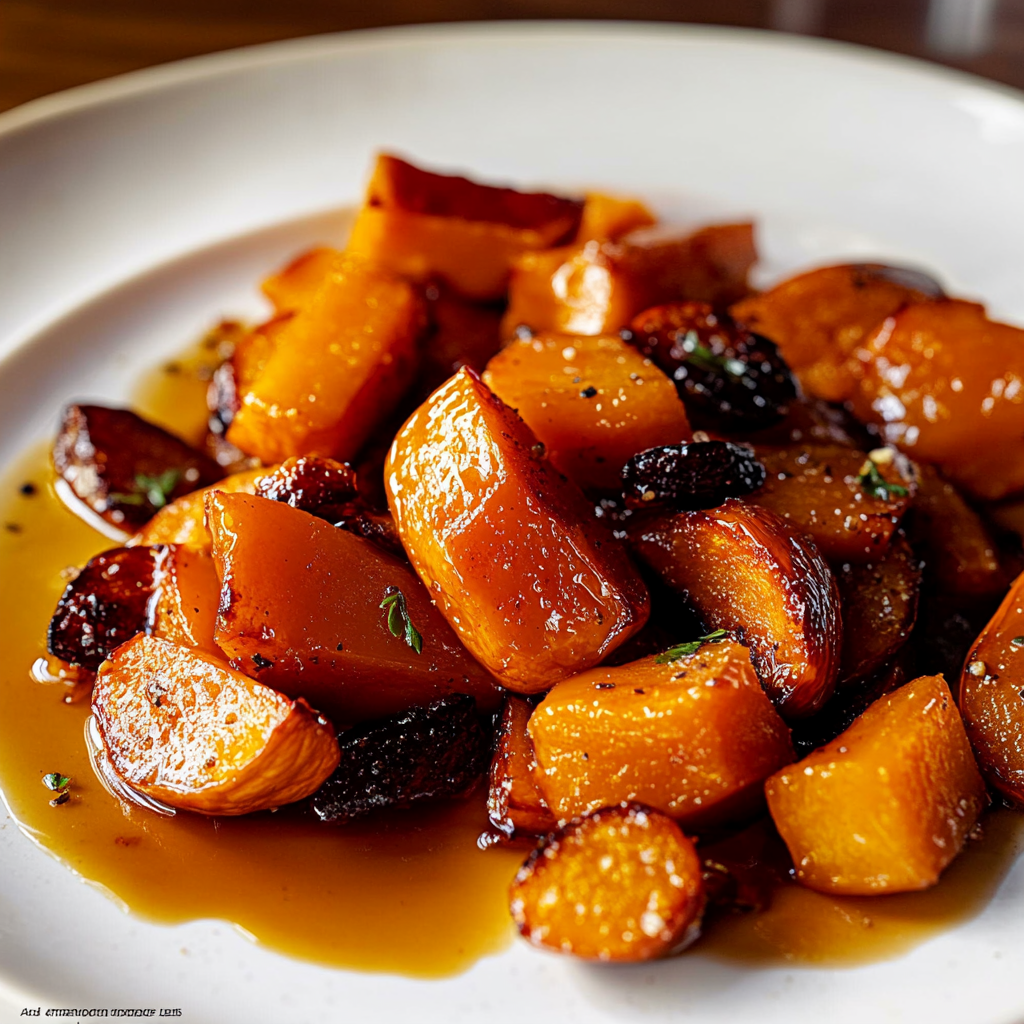
Tips and tricks
To achieve outstanding Roasted Butternut Squash with Maple Glaze, consider implementing a few useful tips and tricks that can enhance your cooking experience.
First, choose ripe butternut squash for optimal flavor. Look for squashes that feel heavy for their size with a smooth skin free of blemishes. This ensures you get a sweet and flavorful base for your dish. If possible, opt for organic varieties as they tend to have better flavor profiles.
Next, consider marinating your squash in maple syrup before roasting. Allowing it to sit in the glaze for at least 30 minutes will deepen its flavor profile, making each bite more delicious. Additionally, tossing in olive oil before adding the glaze helps create a nice caramelized exterior when roasted.
Using parchment paper on your baking sheet can make cleanup much easier while also helping prevent sticking. It promotes even cooking by allowing hot air circulation around the pieces of squash while keeping them from adhering to the tray surface.
For added texture and flavor, try incorporating nuts or seeds during roasting or as a garnish after cooking. Pecans or pumpkin seeds make an excellent choice as they provide crunch and complement the sweetness of the glaze nicely.
Lastly, don’t hesitate to experiment with variations! Adding herbs like rosemary or thyme brings an aromatic quality that pairs well with butternut squash. You may also try varying the glazes by including balsamic vinegar or citrus juice for a fresh twist on this classic recipe.
Implementing these tips will elevate your Roasted Butternut Squash with Maple Glaze experience!
Suggestions for Roasted Butternut Squash with Maple Glaze
When making Roasted Butternut Squash with Maple Glaze, specific suggestions can help enhance your dish further while ensuring it meets everyone’s taste preferences.
Consider pairing your roasted squash with protein sources such as chicken or quinoa for a balanced meal option. These pairings not only complement the flavors but also add nutritional value to your dish without overshadowing its natural sweetness.
Incorporating seasonal vegetables alongside butternut squash can create a colorful medley on your plate while enhancing flavors through contrast. Root vegetables like carrots or parsnips roast beautifully alongside squash and absorb similar seasonings well.
Another suggestion is adjusting the amount of maple syrup based on your sweetness preference. While maple syrup provides great depth of flavor, using less syrup allows other seasonings like garlic or ginger to shine through without overwhelming sweetness.
For those who enjoy spice in their dishes, consider adding chili flakes or cayenne pepper into the glaze mixture for an unexpected heat that balances out the sweetness perfectly.
Lastly, think about serving options! A dollop of Greek yogurt or crème fraîche on top offers creaminess that contrasts nicely against roasted flavors while adding richness without being overly heavy.
By considering these suggestions when preparing Roasted Butternut Squash with Maple Glaze you will create an unforgettable dining experience!
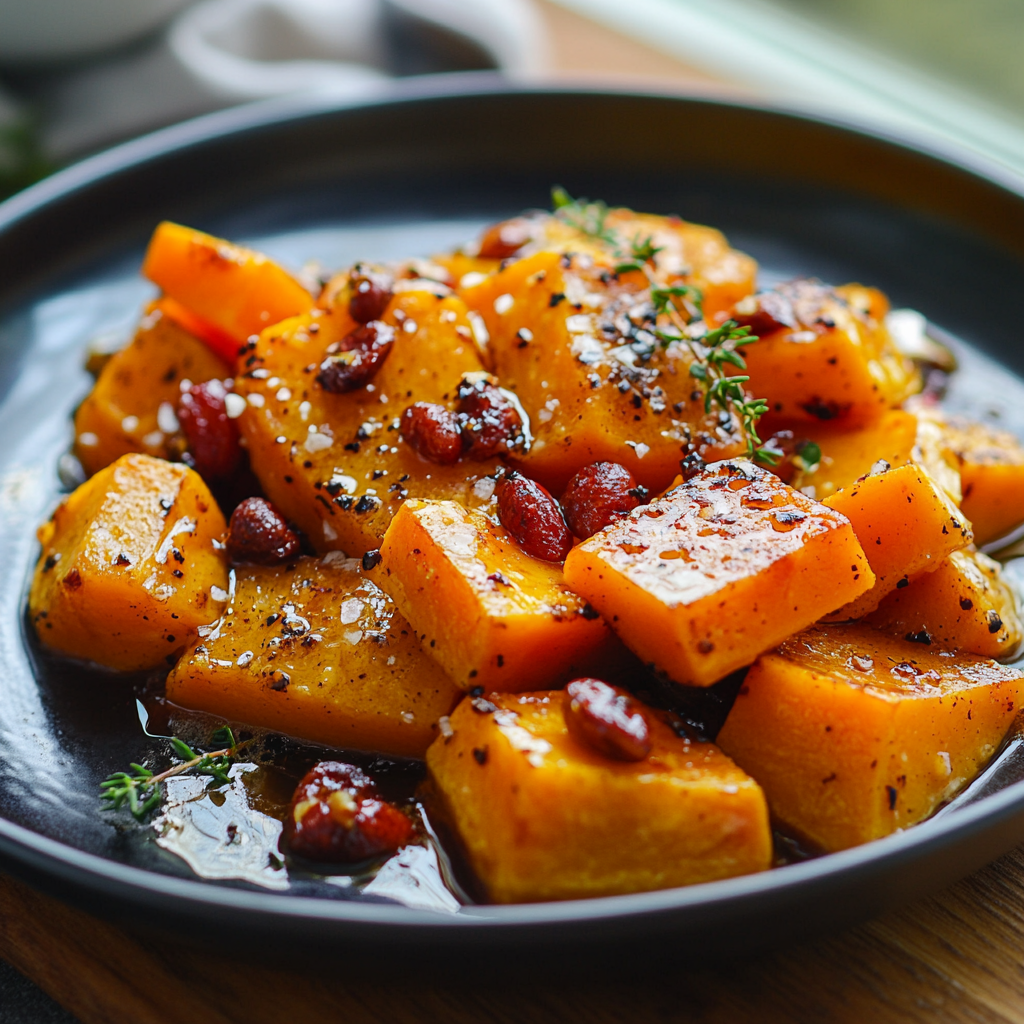
FAQs
What is the best way to cut butternut squash?
Cutting butternut squash requires careful handling due to its tough outer skin. Start by slicing off both ends of the squash; this creates stability when you peel it later. Use a sturdy vegetable peeler or knife to remove the skin carefully before cutting it into uniform pieces—aiming for one-inch cubes helps ensure even cooking during roasting.
Can I prepare Roasted Butternut Squash ahead of time?
Yes! You can prepare Roasted Butternut Squash ahead of time by cutting it into cubes and storing them in an airtight container in the fridge for up to three days prior to roasting day. Just be sure not to toss them in olive oil until you’re ready since this might lead them becoming soggy before cooking time arrives!
How do I know when my butternut squash is done roasting?
To determine if your butternut squash is cooked perfectly during roasting check its color—it should be golden brown around edges—and test tenderness by inserting a fork into one cube; if it slides in easily without resistance then they’re ready! Remember that every oven varies so keep an eye on them after 25 minutes!
Can I use other types of glaze besides maple syrup?
Absolutely! While maple syrup creates delicious results traditional honey works just as well; alternatively balsamic vinegar adds tanginess making it another fantastic option! Feel free experiment varying flavors according personal preference until you discover what truly excites palate!
What dishes pair well with Roasted Butternut Squash?
Roasted Butternut Squash pairs excellently alongside proteins such as grilled chicken breast or roast pork loin creating balanced meals bursting full flavors! Additionally serving over grains like quinoa adds texture nutrition—don’t forget fresh greens mixed salads round things out nicely too!
How do I store leftover roasted butternut squash?
Leftover roasted butternut squash should be stored in airtight containers within refrigerator where they’ll last three-four days maximum! For longer storage consider freezing leftovers instead—just ensure they’re completely cooled before transferring freezer bags preventing excess moisture buildup which could lead mushiness upon reheating later!
Conclusion
In summary, preparing Roasted Butternut Squash with Maple Glaze is both satisfying and rewarding when approached correctly. By avoiding common mistakes such as uneven cutting and inadequate seasoning along with implementing helpful tips like choosing ripe ingredients or experimenting with textures through nuts—you’ll create a flavorful dish everyone will love!
Additionally incorporating complementary side dishes enhances overall dining experience elevating each bite taken further still! With proper storage techniques ensuring freshness between servings allows enjoyment long after initial preparation day concludes too!
Ultimately remember there’s room for creativity within every recipe so don’t hesitate exploring variations suited best tastes preferences whether indulging sweet savory combinations alike—your culinary journey awaits!
